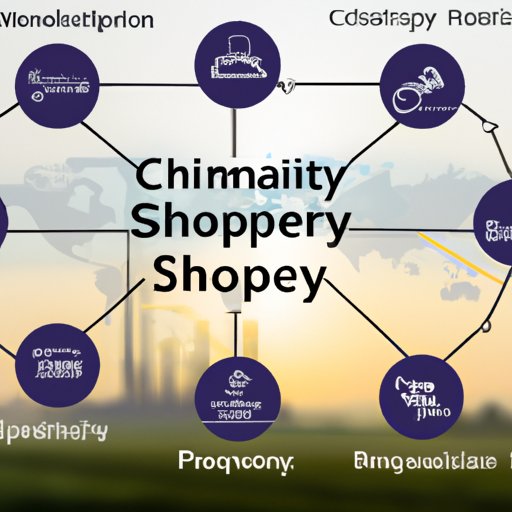Introduction
A supply chain is a system of organizations, people, activities, information, and resources involved in moving a product or service from supplier to customer. The goal of any supply chain is to ensure that products and services are delivered to customers in the most efficient and cost-effective way possible. Understanding the components of a supply chain is essential for businesses to be able to optimize their processes and remain competitive in today’s marketplace.

Exploring the Components of a Supply Chain
The components of a supply chain can be broken down into six main categories: raw materials and resources, manufacturing processes, distribution centers and warehouses, transportation, retailers, and end customers. Each component plays an important role in ensuring that products and services are delivered to customers in a timely and cost-effective manner.
Raw Materials and Resources
Raw materials and resources are the starting point of the supply chain. They are the basic ingredients used to create a product or service. Raw materials can range from simple components such as steel and aluminum to more complex materials such as chemicals and computer chips. Additionally, resources such as labor and energy are also necessary for the production process.
Manufacturing Processes
Manufacturing processes refer to the steps required to turn raw materials into finished products or services. This can include anything from assembly lines to 3D printing and robotics. Manufacturing processes are typically the most time-consuming part of the supply chain, so it is important for businesses to have efficient processes in place to ensure that products and services are delivered on time and within budget.
Distribution Centers and Warehouses
Once products and services are manufactured, they must be stored and distributed to customers. Distribution centers and warehouses play a crucial role in this process by storing and managing inventory. These facilities are typically strategically located near major transportation routes to ensure that goods can be quickly and efficiently delivered to customers.
Transportation
Transportation is the next step in the supply chain. It refers to the movement of goods from one location to another. This can include anything from trucks and trains to ships and airplanes. Choosing the right mode of transportation can significantly reduce costs and improve delivery times.
Retailers
Retailers are the next link in the supply chain. These are the businesses that purchase products from manufacturers and then resell them to customers. Retailers are responsible for getting products to customers in a timely and cost-effective manner. They must also ensure that products are of high quality and meet all customer expectations.
End Customers
Finally, end customers are the ultimate recipients of products and services. End customers can range from individuals to large corporations. It is important for businesses to understand the needs and preferences of their customers in order to ensure that products and services are delivered in a way that meets customer expectations.
A Comprehensive Guide to the Different Parts of a Supply Chain
Understanding each component’s role in the supply chain is key to optimizing the flow of goods and services. It is also important to consider how each component affects the efficiency of the supply chain. For example, if the manufacturing process is slow or inefficient, it can lead to delays in delivery, which can result in unhappy customers and lost sales.
An Overview of What Goes Into Creating a Successful Supply Chain
Creating a successful supply chain requires making sure all components are working together efficiently. This means identifying opportunities for improvement and setting up systems to measure performance. Additionally, businesses must be aware of the changing environment and customer needs in order to remain competitive.

How Companies Can Optimize Their Supply Chains for Maximum Efficiency
There are several ways companies can optimize their supply chains for maximum efficiency. Leveraging technology to streamline processes and utilizing data to make informed decisions are two examples. Establishing partnerships with suppliers and distributors can also help businesses reduce costs and improve delivery times.

How Technology is Disrupting the Supply Chain Landscape
Technology is having a profound impact on the supply chain landscape. Automation, robotics, and artificial intelligence are being used to streamline processes and increase efficiency. Digitization of supply chain processes is also becoming increasingly common, allowing for greater visibility and control. Cloud computing is becoming increasingly popular as well, allowing for better collaboration between different stakeholders in the supply chain.
Conclusion
In conclusion, understanding the components of a supply chain is essential for businesses to optimize their processes and remain competitive in today’s marketplace. There are many different elements that go into creating a successful supply chain, including raw materials and resources, manufacturing processes, distribution centers and warehouses, transportation, retailers, and end customers. Companies can optimize their supply chains for maximum efficiency by leveraging technology, utilizing data, and establishing partnerships with suppliers and distributors. Lastly, technology is rapidly disrupting the supply chain landscape, ushering in a new era of automation, digitization, and cloud computing.
(Note: Is this article not meeting your expectations? Do you have knowledge or insights to share? Unlock new opportunities and expand your reach by joining our authors team. Click Registration to join us and share your expertise with our readers.)
